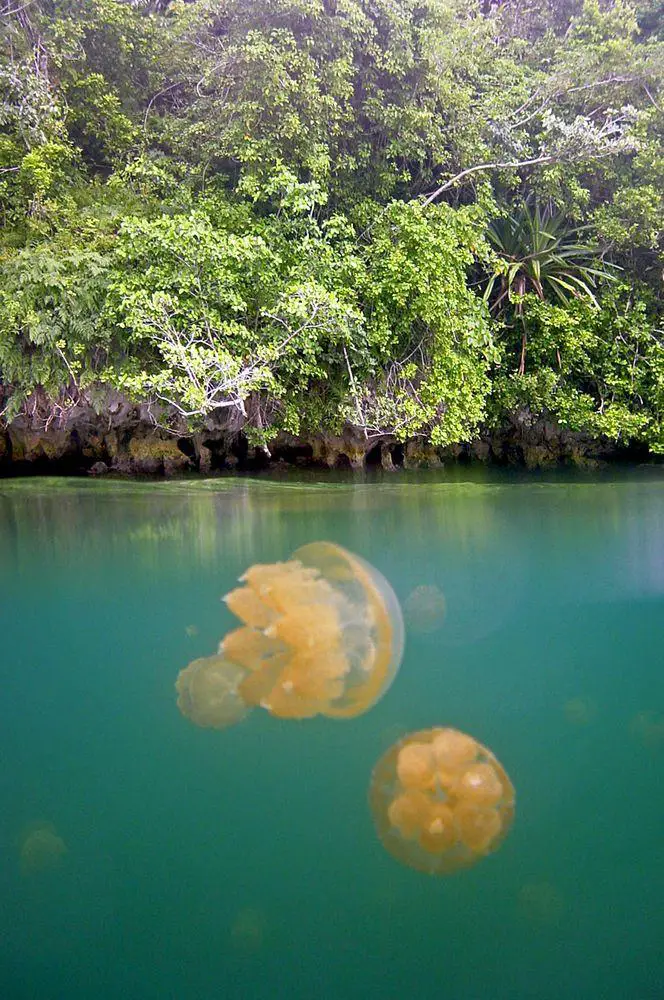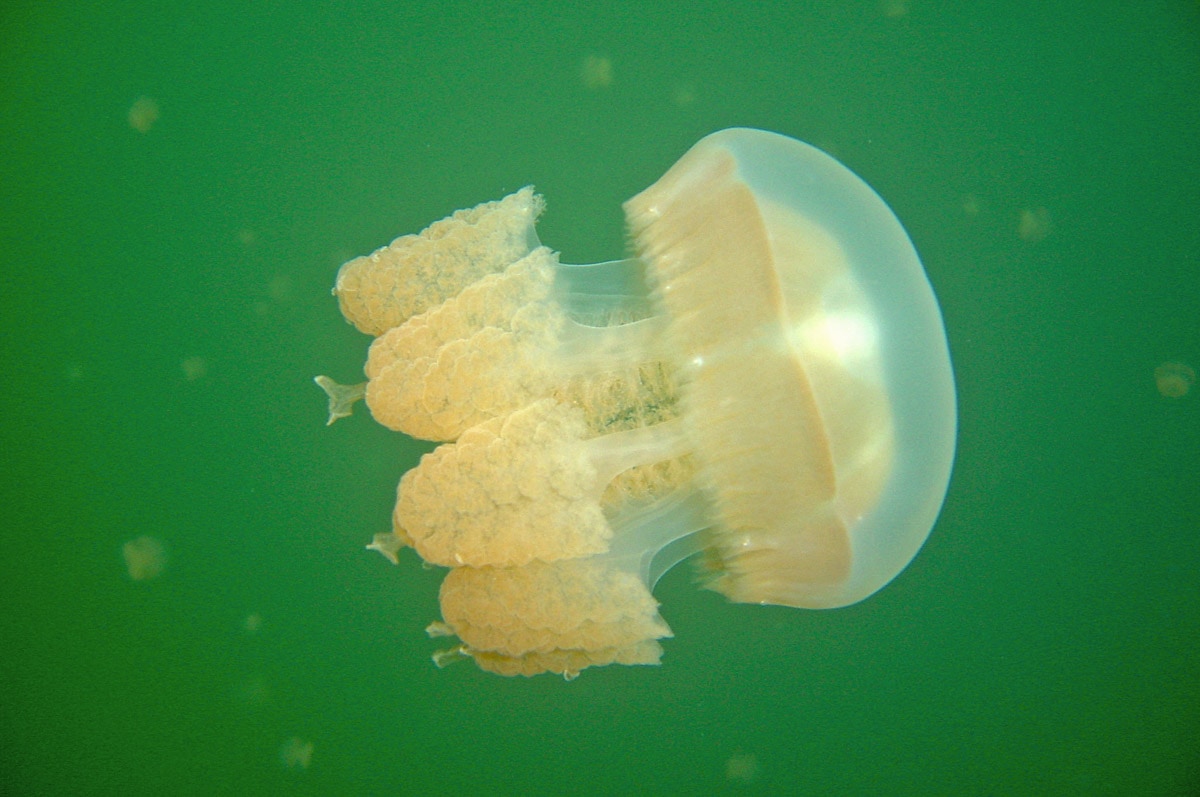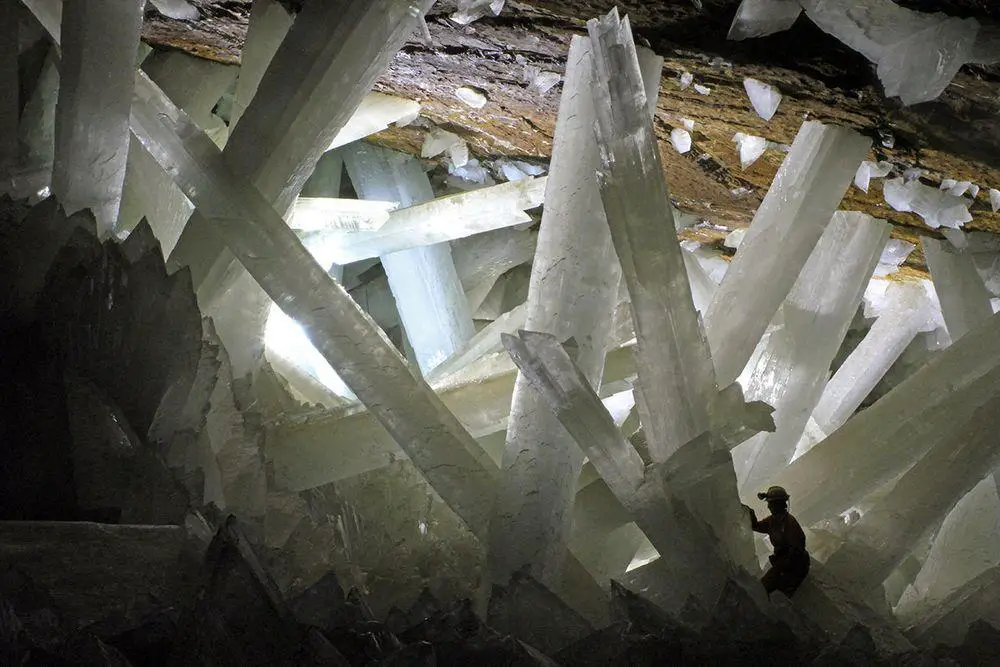World 🢖 Australia and Oceania 🢖 Micronesia 🢖 Palau
Animal colonies 🢔 Ecosystems 🢔 Biological wonders 🢔 Categories of wonders
Wonder
Jellyfish Lake
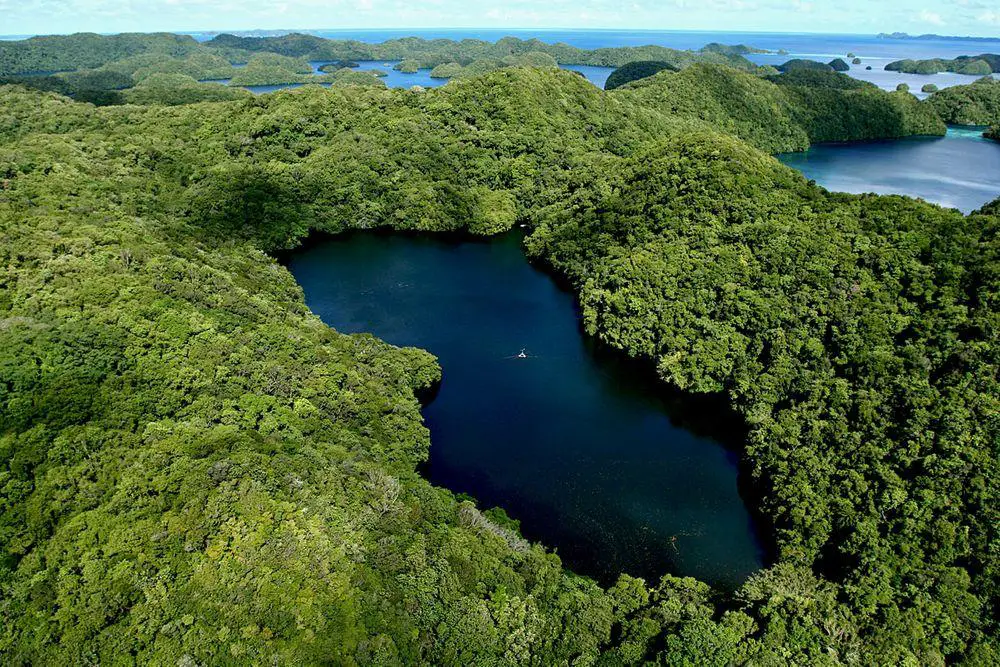
 In short
In short
Palau islands have several exceptional attractions but without a doubt the most outstanding one is Jellyfish Lake. This marine lake is filled with millions of slow floating jellyfishes.
 61.1%
61.1%
GPS coordinates
Location, address
Name in Palauan
Area
Dominating species
Map of the site
If you see this after your page is loaded completely, leafletJS files are missing.
 In detail
In detail
What is marine lake?
There are needed specific conditions to form a marine lake. First, there needs to be an exposed limestone layer: in it by karst processes are created depressions. These depressions need to be rather close to the sea to have a direct connection to the sea later. Then there is needed a sea-level rise which through the fissures and trenches in the limestone fill the depression with seawater. Rain and small streams make the water brackish but the water exchange with the sea continues.
Marine lakes are located in deep valleys with steep banks and in tropical conditions (with even temperatures throughout the year) water does not mix in these lakes. As a result the bottom layer of water sometimes becomes anoxic (meromictic lake).
At some moment the sea level might rise even higher and spill over into the lake. Then in the deppression there might start to live larger sea animals. When the sea recedes, animals become trapped in small lake – and, as the facts show it, in short time adapt to the new conditions, creating new subspecies and species.
Marine lake in many respects resembles extremely small sea. Accident in these small seawater microcosms has placed together occasional members of the extremely diverse marine life of Palau. Scientists, as usual, take the cosy role of spectators – they look how sea animals manage in these unusual conditions and try to learn something new from this.
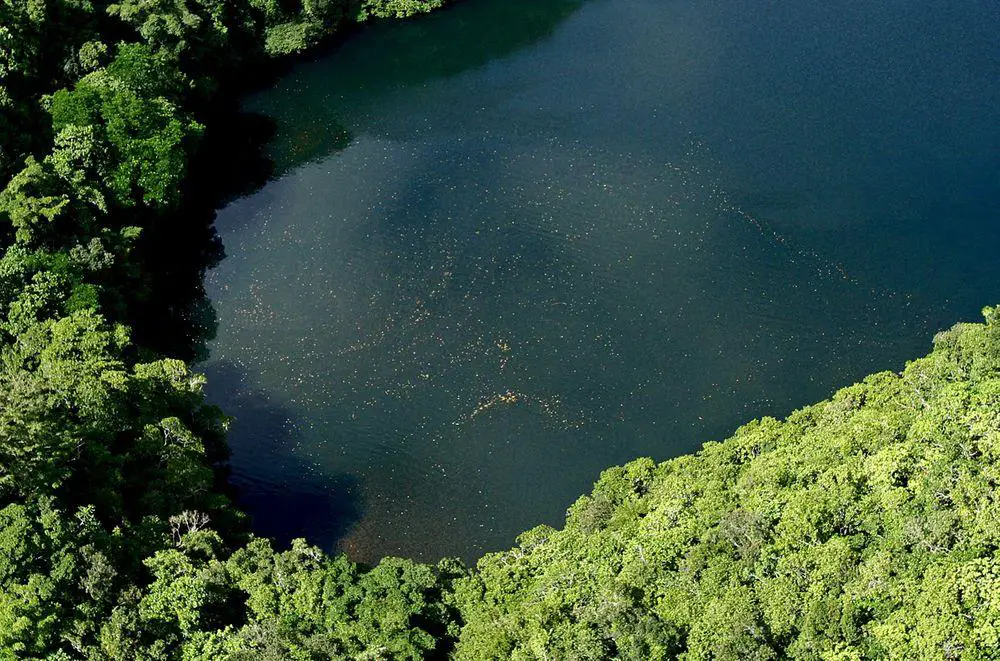
Marine lakes are a specialty of Palau – besides the Jellyfish Lake here are described Clear Lake, Goby Lake, Uet era Ngermeuangel and Uet era Ongael. In the whole world, there are more than 200 marine lakes and some 70 of these unique formations are located in a tiny part of the tiny Palau islands – in Rock Islands. Most other marine lakes are located in the Philippines, Indonesia, Vietnam. In Palau marine lakes have formed in an ancient Miocene reef which is permeated with caverns and fissures.
Bizarre Jellyfish lake
Jellyfish Lake is really small – only some 420 meters long and up to 30 meters deep. What could be unique in such a small place? But Jellyfish Lake is truly unique not only in Palau but in the whole world. Judge yourself:
- Lake is meromictic – it has layers of water which do not mix. The upper layer of the lake contains "common" seawater suitable for common marine species of animals. At the depth of 15 meters though happens a change – here is living a dense layer of bacteria including purple colored ones. Below this layer, there is no oxygen in lake water – and no life. There are only 11 such permanently stratified seawater lakes in Palau.
- Lake still is connected to the sea through three tunnels near the surface of the lake and due to tides, there is an ongoing constant exchange of water. The upper layer of the lake is fresher due to rain but in a few meter depth it is true seawater.
- Lake was formed when sea level subsided 12,000 years ago. Since then life forms in it are isolated from the rest of the world.
- Dominant species in lake is light brown colored, up to 23 cm large golden jellyfish Mastigias cf. papua etpisoni (4) – endemic subspecies met only in this 420 metres long lake. Subspecies has been named after the former Palauan president Ngiratkel Etpison. At some moments the lake has been virtually packed with this animal – in January 2005 there were an estimated 31 million jellyfish. Now (November 2009) there are roughly 4.9 million jellyfish.
- Jellyfish elsewhere in the world do not have any certain patterns of behavior – they just float where the stream brings them. But not in Jellyfish Lake – here the swarm of jellyfish follows the sun throughout the day, avoiding the shadow cast by steep banks of the lake. In the night their swimming though becomes haphazard. Jellyfish follow the light to maintain the process of photosynthesis and to gain energy.
- In some other lakes jellyfish migrate as well. But in Jellyfish Lake they have a special pattern of migration – jellyfish try to be close to shadowed banks while staying themselves in sunlight. This is done to avoid their natural predator – white sea anemone Entacmaea medusivora (Fautin and Fitt, 1991) which sits on the ground and is ready to catch any medusa coming close. Shadowed water creates a barrier between anemones and jellyfish. Don’t worry about anemones (also endemic to this lake) – they get enough jellyfish which does not obey to rules.
Jellyfish disappears and reappears
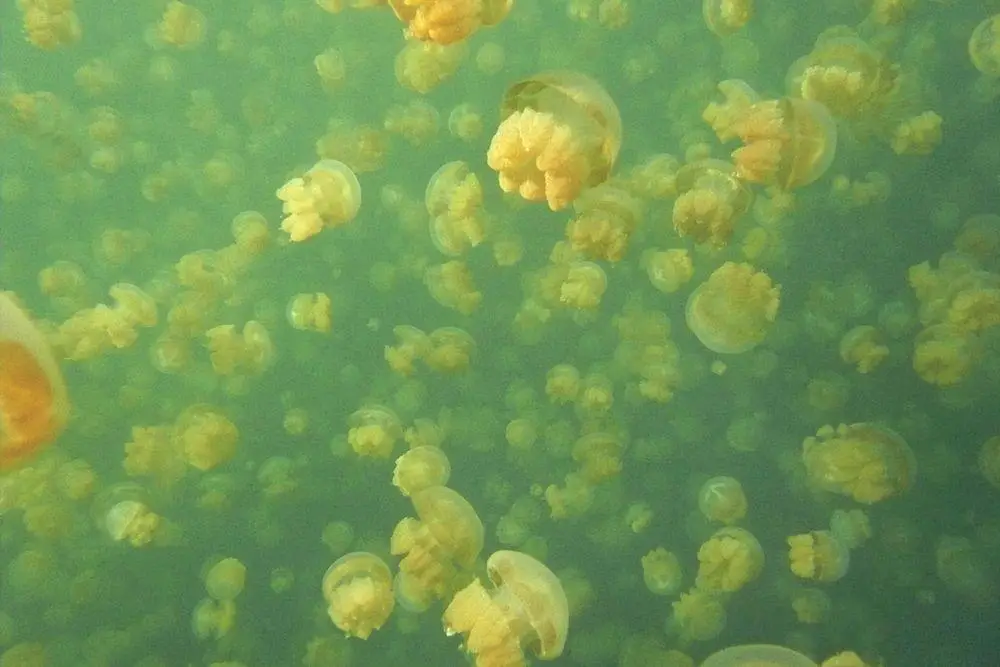
In 1998 it seemed that Jellyfish Lake has lost its charm forever – all the millions of jellyfish Mastigias disappeared.
Hotter water of the lake was to blame – El Niño/La Niña event increased the lake temperature to 35 °C.
Happily jellyfish did not become extinct – after few years the population recovered. But this event was illustrative – very little is needed to eliminate the miracle of Jellyfish Lake.
Tourists…
Diving in Jellyfish Lake certainly is among the most unusual, eerie experiences.
Jellyfish Lake is the first marine lake of Palau open to tourists – since 1986 (2). This was necessary step both to inform the public about fragile wonders of nature and to create additional source of income to Palauans. Approximately 50 – 75% of the guests of Palau visit the lake and quite a few take a dive in it.
But nature conservation officials look at this endless flow of people with concern. This lake is too unique, too small and too fragile for something bad to happen. In fact something has already happened – there has been brought in a new species of sea anemone and nobody can tell what will be the consequences.
The code of conduct of exemplary diver (dive etiquette) in Jellyfish Lake would include such rules (3):
- Be clean (also – no sunscreen) and bring clean equipment with you. This will help to keep ecological balance.
- Wear fins – this would slow down the movements of feet and give a better control, thus decreasing the risc of injury to jellyfish.
- Do not create any bubbles, only snorkeling is allowed here. Bubbles can be trapped by jellyfish and make them helpless decreasing their lifetime.
- Do not stir up sediments – keep away from the edges of lake.
- Move slowly and gently and be quiet. This place deserves silent admiration.
- Do not lift jellyfish out of water – they are very fragile.
- Do not urinate in lake. May be elsewhere it is more or less part of natural processes, but, please, not here.
- Of course, never ever leave any garbage in nature.
Divers themselves should be careful in this unusual lake. Jellyfish is not dangerous – their stings are very weak. But the real danger is the anoxic layer – if one happens to reach it (but reaching 15 metre depth without scuba equipment is little likely), he might be poisoned with hydrogen sulphide entering through the skin.
References
- Coral Reef Research Foundation, Marine Lakes Research Accessed 08.02.10.
- Jellyfish swarms, tourists, and the Christ-child, Mike N. Dawson, Laura E. Martin, Lolita K. Penland. Hydrobiologia 451: 131-144, 2001. Accessed 08.02.10.
- Tour Guide Certification Program Manual, 2nd Edition, 2007 revisions. Koror State Government. Accessed 08.02.10.
- Five new subspecies of Mastigias (Scyphozoa: Rhizostomeae: Mastiigidae) from marine lakes, Palau, Micronesia, Michael N. Dawson. Journal of Marine Biological Association, U.K. 2005., 85., 679-694. Accessed 08.02.10.
Jellyfish Lake is included in the following list:
 Linked articles
Linked articles
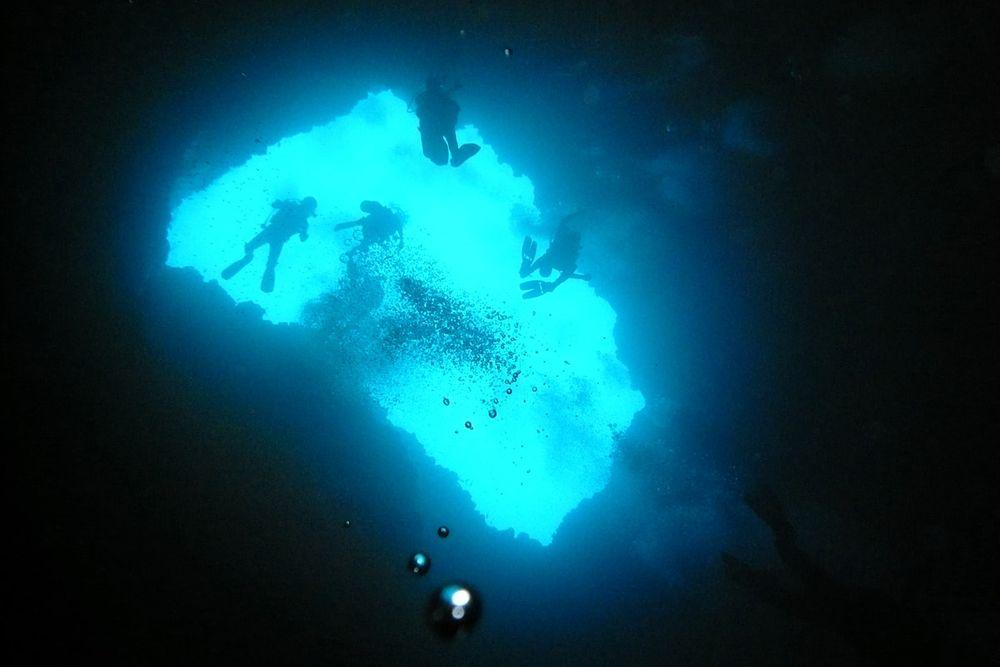
Wonders of Palau
Although Palau is small in size, it offers a surprising diversity of interesting monuments. Several of these monuments are true wonders and there are several unresolved mysteries related to Palau.
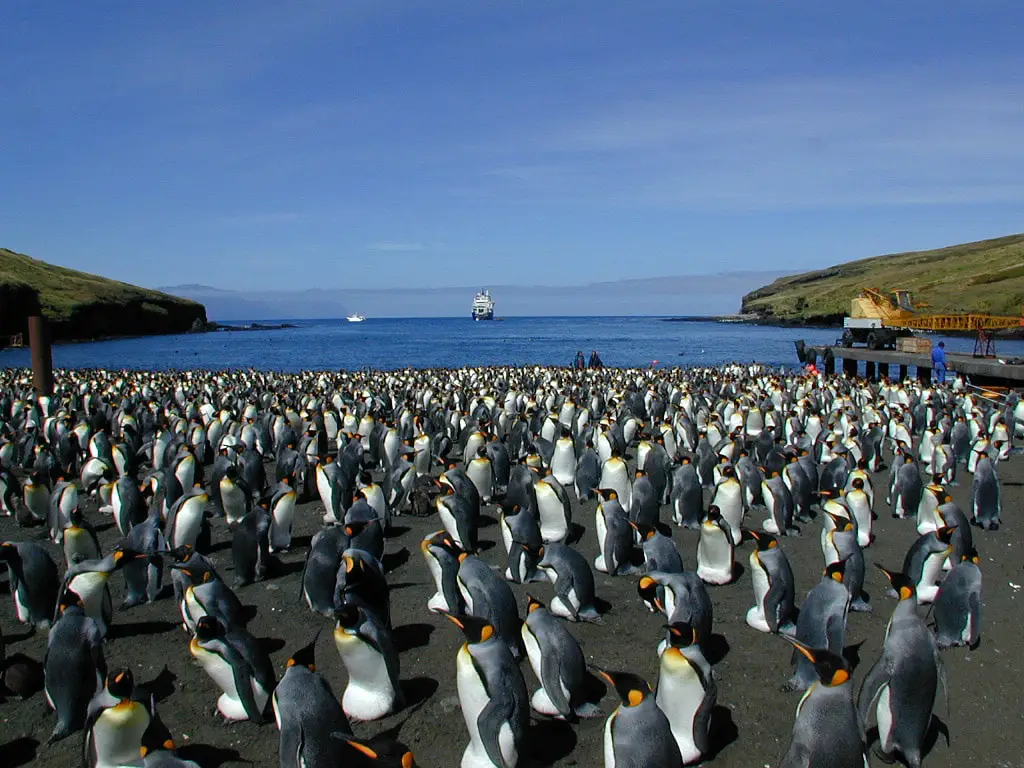
Animal colonies
The sight of the gathering of countless penguins or antelopes is very fascinating and intriguing. There are locations in the world where such gatherings are permanent or regular, and: if there is a location with intriguing sights – this is a landmark!
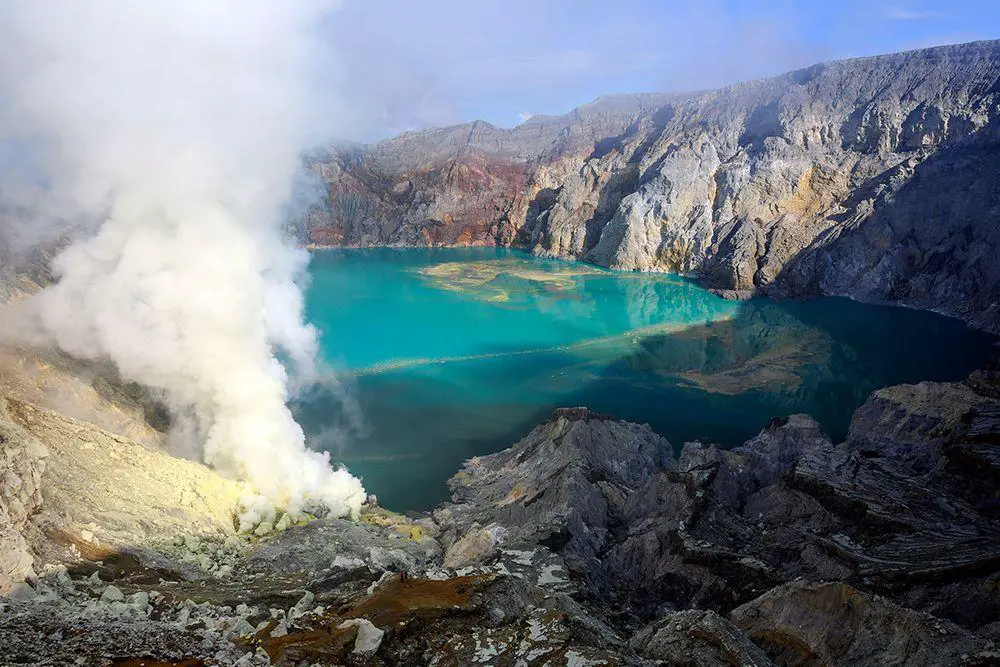
Lakes and streams
There are many factors that can make lakes, sea bays, or rivers unusual. Some lakes have unusual chemical properties and even do not contain water at all – such as lava lakes. Others may have unusual animals living in them or… legends about such animals.
 Recommended books
Recommended books
Bucket List Adventures: 10 Incredible Journeys to Experience Before You Die
Author Annette White has made a second career out of writing her bucket list… and then crossing things off of it! One day this owner of a Michelin-recommended restaurant in Northern California decided to live her dream.
Diving & Snorkeling Guide to Palau and Yap 2016
Palau is one of the world’s underwater wonders and Yap is both the most culturally intact isle in the region and a worthy diving and snorkeling mecca in its own right. This guide is new for 2016, with new images, more information on the outer atolls, and updated dive site information.

